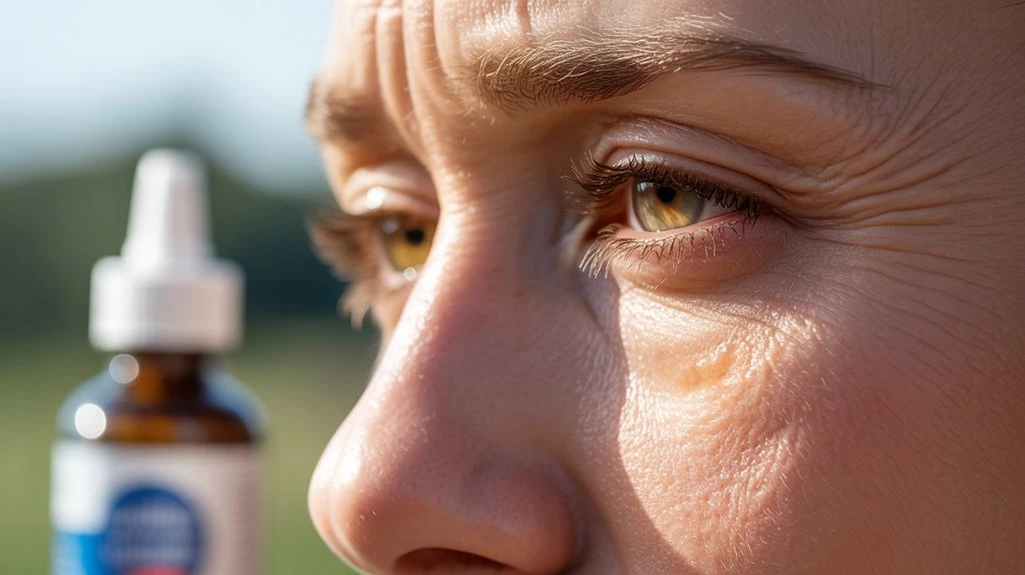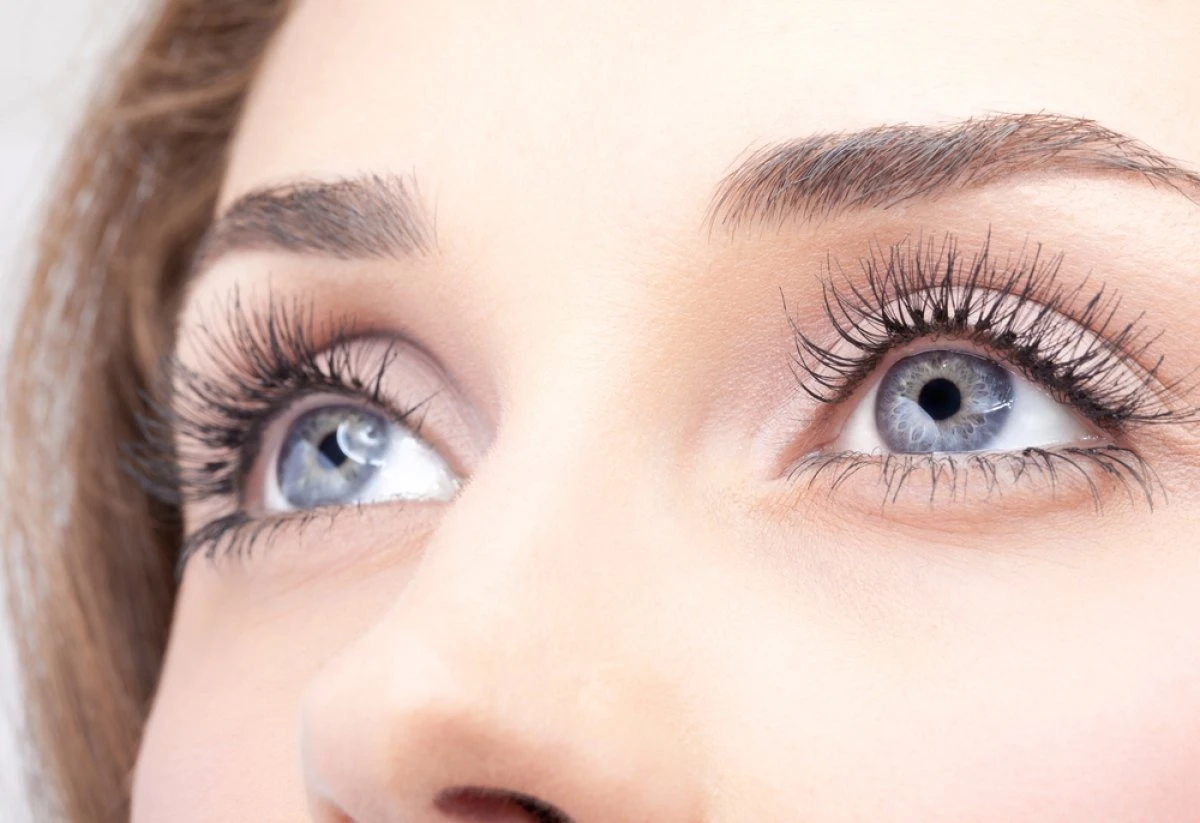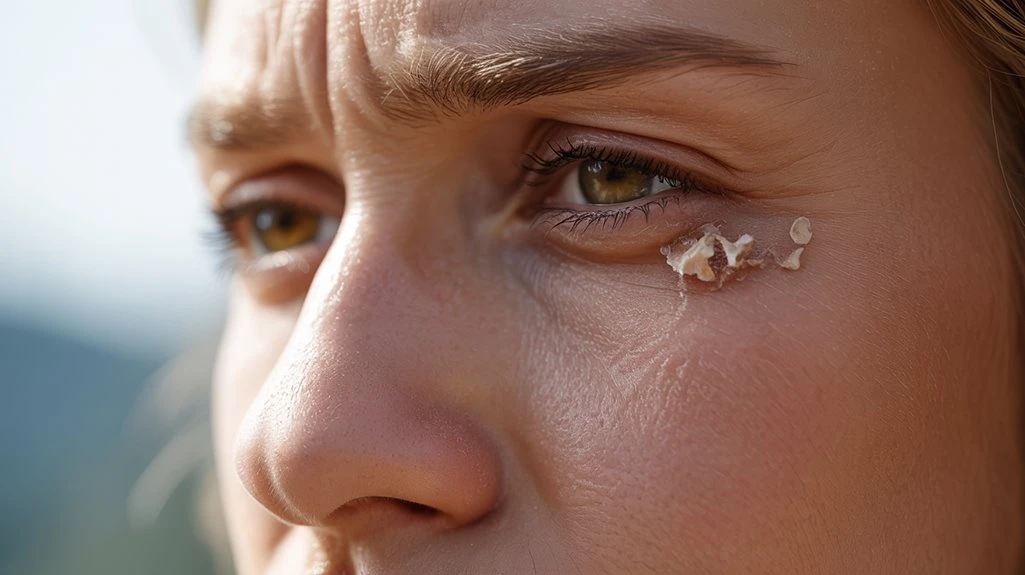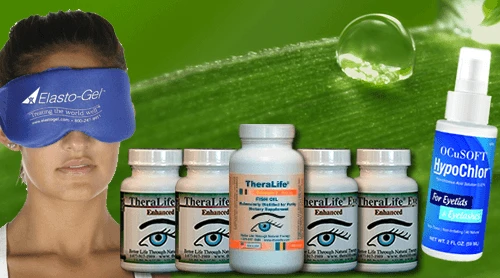If your have crusty eyes all day, it may be due to eyelid margin inflammation from conditions like blepharitis, meibomian gland dysfunction, or chronic conjunctivitis. These issues can disrupt the normal tear film, causing persistent crusting, redness, and irritation. Factors such as allergies, bacterial or viral infections, and poor eyelid hygiene can also contribute to this problem.
TheraLife offers an advanced solution for these concerns as it’s the only company providing oral eye treatment care. TheraLife’s unique oral formulations target the root causes of dry eyes and related conditions, offering relief from symptoms like crusting and redness. Their natural, patented products are designed to enhance the body’s ability to produce balanced tears, providing a holistic approach to eye health.
If symptoms like pain, swelling, or vision changes accompany the crusting, it is essential to seek prompt evaluation. TheraLife provides valuable insights and effective management options for underlying causes, ensuring comprehensive care for your eye health needs.
Get Rid Of Crusty Eyes – Treat Your Dry Eyes With TheraLife
Crusty Eyes Management with TheraLIfe All In One Dry Eye Starter Kit.
Add To Cart
Key Takeaways
- Persistent eye crustiness is often caused by chronic eyelid inflammation such as blepharitis or meibomian gland dysfunction.
- Allergies and exposure to irritants like pollen or dust can trigger ongoing eye discharge and crust formation.
- Bacterial or viral conjunctivitis leads to excessive discharge, forming crusts that may persist throughout the day.
- Inadequate eyelid hygiene allows debris and bacteria to accumulate, worsening crusty buildup.
- Seek medical attention if you experience pain, vision changes, persistent swelling, or thick yellow-green discharge.
Common Causes of Persistent Crusty Eyes

Although occasional eye crust is normal, persistent or excessive crustiness often indicates an underlying ocular condition.
You may encounter chronic crusting from blepharitis, where inflammation of the eyelid margins disrupts eye hygiene and leads to debris accumulation.
Meibomian gland dysfunction is another frequent cause, as obstructed glands compromise tear quality, resulting in unstable tear film and increased discharge.
Conjunctivitis, whether bacterial or viral, also produces excessive exudate that forms crusts along your eyelids.
Inadequate eye hygiene, such as infrequent eyelid cleansing, can exacerbate these conditions by allowing debris and bacteria to accumulate.
Disorders impacting tear quality, such as dry eye syndrome, lead to poor lubrication and increased mucous production, further contributing to persistent crustiness.
Diagnostic evaluation focuses on identifying these etiologies for targeted management.
Proper eyelid hygiene practices are crucial in preventing exacerbation of blepharitis-related symptoms and maintaining ocular health.
Allergies and Environmental Factors for Crusty Eyes
You may experience increased ocular crusting when exposed to common airborne irritants such as pollen, dust mites, or pet dander. Seasonal allergy symptoms often include conjunctival injection, pruritus, and watery discharge, all of which contribute to periocular debris. It’s important to assess for indoor triggers like mold spores or household chemicals, as these can exacerbate allergic conjunctivitis and worsen crust formation. Chronic conditions like anterior blepharitis can resemble dandruff at the base of the eyelashes, further contributing to eye crustiness.
Common Airborne Irritants
Airborne irritants, including pollen, dust mites, pet dander, and environmental pollutants, frequently trigger ocular surface inflammation and contribute to crust formation along the eyelid margins. When you’re exposed to compromised air quality, particulate matter can deposit on the ocular surface, disrupting the tear film and causing irritation. Pollution effects such as increased nitrogen dioxide or particulate pollution correlate with higher rates of blepharitis and conjunctival inflammation, both of which present with persistent lid debris. Protective eyewear acts as a barrier against pollen and airborne irritants, reducing allergic reactions and symptoms like conjunctivitis. You should consider potential sources—indoor allergens like dust mites or outdoor factors such as pollen and smog—when evaluating your symptoms. Diagnostic assessment often involves history-taking focused on environmental exposures, with slit-lamp examination revealing debris and conjunctival injection. Addressing air quality and identifying irritant sources are essential for targeted management.
Seasonal Allergy Symptoms
When seasonal allergens like pollen proliferate, they often induce ocular symptoms characterized by itching, redness, and the formation of crust along the eyelid margins. You may notice increased tearing and discomfort, especially after outdoor exposure during peak pollen seasons. These manifestations result from an IgE-mediated hypersensitivity response, causing inflammation of the conjunctiva and meibomian glands. Crust formation is a classic sign of allergic conjunctivitis, frequently exacerbated by repetitive eye rubbing. Recognizing these seasonal triggers is essential for diagnostic accuracy, as symptoms often coincide with periods of high airborne allergen concentrations. Implementing allergy management strategies—such as minimizing outdoor activity during high pollen counts and using antihistamine drops—can mitigate ocular surface inflammation and reduce crust formation. Eye crust, or sleep crust, forms from eye discharge during sleep, consisting of a mixture of mucus, skin cells, oils, and tears that accumulate when not blinking. Consult an eye care provider for tailored evaluation and intervention.
Indoor Triggers Explained
Although outdoor allergens garner much attention, indoor triggers—such as dust mites, pet dander, and mold spores—often provoke similar ocular symptoms, including eyelid crusting, pruritus, and conjunctival erythema.
You’re likely to encounter these allergens in environments with elevated indoor humidity, which fosters mold growth and dust mite proliferation.
Suboptimal lighting conditions may make it harder to notice environmental irritants or accumulations of allergenic particles.
Diagnostic evaluation should include a detailed environmental history, focusing on exposure to household pets, visible mold, or recent changes in cleaning routines.
Consider monitoring fluctuations in indoor humidity, as levels above 50% can exacerbate allergen presence.
Addressing these indoor triggers through allergen mitigation and environmental control is essential for reducing your persistent ocular surface symptoms and improving overall comfort.
For individuals with allergies, eye conditions like blepharitis can exacerbate crusty eyes and require diligent hygiene practices to manage symptoms effectively.
Infections That Lead to Crusty Eyes
Since infectious agents often disrupt the normal function of the ocular surface, several eye infections commonly cause crusty eyelids and discharge. When you experience persistent crusting, clinicians consider infectious etiologies, particularly viral conjunctivitis and bacterial infections. These conditions provoke an inflammatory response, increasing mucopurulent or serous exudate.
You’ll often notice that symptoms worsen upon waking due to accumulation of discharge overnight.
To differentiate between infectious causes, pay attention to these clinical features:
- Viral conjunctivitis: Typically presents with watery discharge, redness, and a gritty sensation. It’s highly contagious.
- Bacterial infections: Characterized by thicker, yellow-green discharge, eyelid swelling, and sometimes matting of lashes.
- Blepharitis: Involves chronic inflammation at the eyelid margin, leading to recurrent crusting and debris.
Prompt diagnosis guides effective management and prevents complications. Understanding meibomian gland dysfunction is crucial, as it is often associated with blepharitis and can exacerbate symptoms by blocking oil glands.
The Role of Dry Eyes and Tear Production Causing Crusty Eyes

If your eyes feel gritty and you notice persistent crusting along the eyelid margins, inadequate tear production or poor tear quality may be an important contributor. The tear film, consisting of lipid, aqueous, and mucin layers, is critical for ideal eye lubrication and surface protection. Deficiencies in any layer disrupt this balance, leading to excessive evaporation or insufficient spreading of tears. These disruptions can result in chronic dryness, which frequently manifests as crusting due to the accumulation of cellular debris and mucus. Chronic dry eye conditions can also lead to complications such as blepharitis and MGD, further exacerbating symptoms.
| Symptom | Diagnostic Indicator |
|---|---|
| Grittiness | Reduced tear breakup time |
| Persistent crusting | Schirmer test abnormalities |
| Redness or irritation | Staining of ocular surface |
Clinical evaluation often includes tear film assessment and measurement of tear production to identify underlying dysfunction. Addressing these factors can greatly reduce crusting.
Blepharitis: A Frequent Culprit For Crusty Eyes
You might notice redness, irritation, and crusting along your eyelid margins—key signs of blepharitis. This condition often results from bacterial colonization, seborrheic dermatitis, or dysfunction of the meibomian glands. Recognizing these etiologies helps you target treatment and reduce recurrence. Regular eyelid hygiene is crucial to minimize symptom recurrence.
Common Blepharitis Symptoms
Although crusty eyelids can result from various conditions, blepharitis frequently presents with hallmark symptoms such as eyelid margin redness, swelling, and flaky debris at the lash line.
You may notice persistent irritation, a sensation of grittiness, or even mild discomfort throughout the day. Clinical evidence indicates that compromised eyelid hygiene often contributes to the persistence and severity of these manifestations.
If you’re experiencing these issues, consider whether the following symptoms align with your condition:
- Persistent crusty eyelids—especially upon waking, with visible flakes or debris along the lashes.
- Chronic eyelid redness and swelling—not limited to acute episodes but ongoing throughout the day.
- Itching or burning sensations—sometimes accompanied by excessive tearing or sensitivity to light.
Prompt recognition aids effective diagnosis and management. Additionally, maintaining proper eyelid hygiene can prevent bacterial growth and help manage blepharitis symptoms effectively.
Causes of Eyelid Inflammation
When eyelid inflammation arises, blepharitis often stands out as a primary cause due to chronic bacterial colonization, sebaceous gland dysfunction, or hypersensitivity reactions along the eyelid margin.
You’ll frequently encounter Staphylococcus species or Demodex mites as inflammation triggers, disrupting the delicate ocular surface environment. Poor eyelid hygiene exacerbates this process, allowing microbial biofilm and debris to accumulate, further irritating the meibomian glands and perpetuating inflammation.
Sebaceous gland dysfunction, particularly meibomian gland dysfunction (MGD), impairs lipid secretion, destabilizing the tear film and increasing susceptibility to crusting and redness.
In some cases, contact allergies or systemic dermatological conditions, such as rosacea or seborrheic dermatitis, contribute to chronic inflammatory changes.
Mayo Clinic recommendations emphasize the importance of eyelid hygiene as a crucial component in managing blepharitis symptoms.
When Crusty Eyes Signal a More Serious Problem
While mild eye crust is common, persistent or worsening discharge may indicate underlying pathology such as blepharitis, conjunctivitis, or even keratitis.
You shouldn’t ignore chronic crusting, especially if it’s accompanied by symptoms affecting eye health and vision issues. These conditions can signify infection or inflammation, sometimes threatening ocular structures or visual acuity if left untreated.
It’s critical to recognize when crusting signals a more serious problem, prompting timely evaluation by an eye care professional.
Here are key warning signs to watch for:
- Increased redness or swelling—Suggests active inflammation or infection.
- Pain, photophobia, or blurred vision—May indicate corneal involvement or deeper ocular pathology.
- Persistent or thick yellow-green discharge—Can signal bacterial infection requiring targeted therapy.
Early recognition helps prevent complications and preserves your vision.
Home Remedies and Self-Care Tips For Crusty Eyes
If you experience mild crusting around your eyes without signs of infection or vision changes, you can implement several evidence-based home measures to minimize discomfort and prevent complications.
Begin by applying soothing compresses: use a clean, warm, damp cloth over closed eyelids for 5–10 minutes to help loosen debris and facilitate gentle removal.
Cleanse your eyelid margins with a sterile cotton swab moistened in warm water, using horizontal strokes to dislodge crusts.
Integrate natural treatments such as preservative-free artificial tears to reduce ocular surface irritation.
Maintain strict hand hygiene to prevent secondary contamination.
Avoid rubbing your eyes, which can exacerbate mechanical irritation.
Daily eyelid hygiene routines have demonstrated efficacy in reducing recurrence of crusting and alleviating symptoms associated with mild, non-infectious etiologies such as blepharitis.
When to Seek Professional Help For Crusty Eyes

Persistent or worsening eye crusting despite diligent home care may indicate an underlying pathology that warrants medical evaluation.
It’s important to recognize when symptoms exceed routine management and require professional evaluation to guarantee the best possible eye care.
Clinical indicators can help you identify when immediate attention is necessary. Watch for the following:
- Severe redness, pain, or visual changes—these may signal infection, corneal involvement, or other acute ocular pathology.
- Persistent discharge or swelling—if crusting continues despite hygiene measures, underlying conditions such as blepharitis, conjunctivitis, or meibomian gland dysfunction may be present.
- Associated systemic symptoms—fever, facial swelling, or general malaise could indicate a more extensive infectious process.
Prompt consultation with an eye care specialist guarantees accurate diagnosis and targeted intervention, reducing the risk of complications.
Get Rid Of Crusty Eyes – Treat Your Dry Eyes With TheraLife
Add To Cart
Frequently Asked Questions
Can Diet or Nutrition Affect Eye Crustiness?
Diet and nutrition can influence eye crustiness through nutritional deficiencies and hydration levels.
If you lack vitamin A or omega-3 fatty acids, your tear production and ocular surface health may be compromised, increasing discharge.
Inadequate hydration levels can reduce tear film stability, exacerbating debris accumulation.
You should assess your dietary intake and fluid consumption as part of a diagnostic evaluation to determine if nutritional or hydration imbalances contribute to persistent eye crustiness.
Does Screen Time Worsen Eye Crustiness?
It’s no coincidence that when you experience screen fatigue, you also notice increased eye discharge.
Prolonged exposure to blue light from digital devices can reduce blink rate, leading to inadequate tear film distribution and evaporative dry eye. This disruption often results in the accumulation of ocular debris and crustiness.
If you’re spending hours on screens, you’re placing your eyes at greater risk for these diagnostic symptoms.
Consider regular breaks to alleviate these effects.
Are Certain Cosmetics Linked to Crusty Eyes?
Certain cosmetic ingredients can trigger allergy reactions or irritant contact dermatitis, leading to eyelid inflammation and increased ocular discharge.
You may notice persistent crusting if you’re sensitive to preservatives, fragrances, or pigments commonly found in eye makeup.
Clinically, patch testing helps identify responsible allergens.
If you suspect cosmetics are involved, discontinue use and consult an ophthalmologist or dermatologist.
They’ll evaluate for allergic conjunctivitis or blepharitis and recommend evidence-based management strategies.
Can Pets Contribute to Chronic Eye Crustiness?
If you let the cat out of the bag, you might discover pet allergens markedly impact chronic eye crustiness.
Evidence shows that dander from pets can trigger allergic conjunctivitis, increasing mucous discharge.
You should assess your environment and practice stringent eye hygiene to reduce exposure.
Diagnostic evaluation, such as skin prick testing or specific IgE blood tests, can confirm sensitivities.
Addressing pet allergens often alleviates symptoms and improves ocular surface health.
Does Age Increase the Risk of Persistent Eye Crustiness?
As you age, your risk for persistent eye crustiness does increase due to age related conditions like blepharitis, meibomian gland dysfunction, and dry eye syndrome.
These conditions impair tear film quality and eyelid function, leading to chronic debris. Evidence shows that diminished eye hygiene and decreased tear production are common in older adults, further exacerbating symptoms.
A clinical assessment can help diagnose underlying causes and guide targeted management strategies for ideal ocular surface health.
Get Rid Of Crusty Eyes – Treat Your Dry Eyes With TheraLife
Add To Cart
Conclusion
If you’re dealing with persistent crusty eyes, it’s essential to address the root causes, such as blepharitis, chronic dry eye, or infections. These conditions require targeted management, and early diagnosis can prevent complications. Theralife stands out by offering the only oral eye treatment care available, providing a unique solution for those struggling with these issues. Their product line is designed to restore ocular health and improve comfort, leading to clearer vision and peace of mind. While self-care can provide temporary relief, Theralife’s comprehensive approach offers long-term solutions and relief from ongoing symptoms.
References
- 1.
- Shekhawat NS, Shtein RM, Blachley TS, Stein JD. Antibiotic Prescription Fills for Acute Conjunctivitis among Enrollees in a Large United States Managed Care Network. Ophthalmology. 2017 Aug;124(8):1099-1107. [PMC free article] [PubMed]
- 2.
- Smith AF, Waycaster C. Estimate of the direct and indirect annual cost of bacterial conjunctivitis in the United States. BMC Ophthalmol. 2009 Nov 25;9:13. [PMC free article] [PubMed]
- 3.
- 4.
- de Laet C, Dionisi-Vici C, Leonard JV, McKiernan P, Mitchell G, Monti L, de Baulny HO, Pintos-Morell G, Spiekerkötter U. Recommendations for the management of tyrosinaemia type 1. Orphanet J Rare Dis. 2013 Jan 11;8:8. [PMC free article] [PubMed]
- 5.
- Sati A, Sangwan VS, Basu S. Porphyria: varied ocular manifestations and management. BMJ Case Rep. 2013 May 22;2013 [PMC free article] [PubMed]
- 6.
- Azari AA, Barney NP. Conjunctivitis: a systematic review of diagnosis and treatment. JAMA. 2013 Oct 23;310(16):1721-9. [PMC free article] [PubMed]
- 7.
- 8.
- Shields T, Sloane PD. A comparison of eye problems in primary care and ophthalmology practices. Fam Med. 1991 Sep-Oct;23(7):544-6. [PubMed]
- 9.
- 10.
- Turaka K, Penne RB, Rapuano CJ, Ayres BD, Abazari A, Eagle RC, Hammersmith KM. Giant fornix syndrome: a case series. Ophthalmic Plast Reconstr Surg. 2012 Jan-Feb;28(1):4-6. [PubMed]
- 11.
- Satpathy G, Behera HS, Ahmed NH. Chlamydial eye infections: Current perspectives. Indian J Ophthalmol. 2017 Feb;65(2):97-102. [PMC free article] [PubMed]
- 12.
- Bhosai SJ, Bailey RL, Gaynor BD, Lietman TM. Trachoma: an update on prevention, diagnosis, and treatment. Curr Opin Ophthalmol. 2012 Jul;23(4):288-95. [PMC free article] [PubMed]
- 13.
- 14.
- Makker K, Nassar GN, Kaufman EJ. StatPearls [Internet]. StatPearls Publishing; Treasure Island (FL): Jul 17, 2023. Neonatal Conjunctivitis. [PubMed]
- 15.
- Hoffman J. Adenovirus: ocular manifestations. Community Eye Health. 2020;33(108):73-75. [PMC free article] [PubMed]
- 16.
- Giladi N, Herman J. Pharyngoconjunctival fever. Arch Dis Child. 1984 Dec;59(12):1182-3. [PMC free article] [PubMed]
- 17.
- Meyer-Rüsenberg B, Loderstädt U, Richard G, Kaulfers PM, Gesser C. Epidemic keratoconjunctivitis: the current situation and recommendations for prevention and treatment. Dtsch Arztebl Int. 2011 Jul;108(27):475-80. [PMC free article] [PubMed]
- 18.
- Wright PW, Strauss GH, Langford MP. Acute hemorrhagic conjunctivitis. Am Fam Physician. 1992 Jan;45(1):173-8. [PubMed]
- 19.
- Saleh D, Yarrarapu SNS, Sharma S. StatPearls [Internet]. StatPearls Publishing; Treasure Island (FL): Aug 28, 2023. Herpes Simplex Type 1. [PubMed]
- 20.
- Yoser SL, Forster DJ, Rao NA. Systemic viral infections and their retinal and choroidal manifestations. Surv Ophthalmol. 1993 Mar-Apr;37(5):313-52. [PubMed]
- 21.
- Meza-Romero R, Navarrete-Dechent C, Downey C. Molluscum contagiosum: an update and review of new perspectives in etiology, diagnosis, and treatment. Clin Cosmet Investig Dermatol. 2019;12:373-381. [PMC free article] [PubMed]
- 22.
- La Rosa M, Lionetti E, Reibaldi M, Russo A, Longo A, Leonardi S, Tomarchio S, Avitabile T, Reibaldi A. Allergic conjunctivitis: a comprehensive review of the literature. Ital J Pediatr. 2013 Mar 14;39:18. [PMC free article] [PubMed]
- 23.
- Villegas BV, Benitez-Del-Castillo JM. Current Knowledge in Allergic Conjunctivitis. Turk J Ophthalmol. 2021 Feb 25;51(1):45-54. [PMC free article] [PubMed]
- 24.
- Kaur K, Gurnani B. StatPearls [Internet]. StatPearls Publishing; Treasure Island (FL): Jun 11, 2023. Vernal Keratoconjunctivitis. [PubMed]
- 25.
- Sobolewska B, Zierhut M. [Atopic keratoconjunctivitis]. Klin Monbl Augenheilkd. 2014 May;231(5):512-7. [PubMed]
- 26.
- Kari O, Saari KM, Haahtela T. [Non-allergic eosinophilic conjunctivitis]. Duodecim. 2010;126(10):1145-50. [PubMed]
- 27.
- Resano A, Esteve C, Fernández Benítez M. Allergic contact blepharoconjunctivitis due to phenylephrine eye drops. J Investig Allergol Clin Immunol. 1999 Jan-Feb;9(1):55-7. [PubMed]
- 28.
- Donshik PC, Ehlers WH, Ballow M. Giant papillary conjunctivitis. Immunol Allergy Clin North Am. 2008 Feb;28(1):83-103, vi. [PubMed]
- 29.
- Pokroy R, Marcovich A. Self-inflicted (factitious) conjunctivitis. Ophthalmology. 2003 Apr;110(4):790-5. [PubMed]
- 30.
- Schuster V, Seregard S. Ligneous conjunctivitis. Surv Ophthalmol. 2003 Jul-Aug;48(4):369-88. [PubMed]
- 31.
- Dixon MK, Dayton CL, Anstead GM. Parinaud’s Oculoglandular Syndrome: A Case in an Adult with Flea-Borne Typhus and a Review. Trop Med Infect Dis. 2020 Jul 29;5(3) [PMC free article] [PubMed]
- 32.
- Lahoti S, Weiss M, Johnson DA, Kheirkhah A. Superior limbic keratoconjunctivitis: a comprehensive review. Surv Ophthalmol. 2022 Mar-Apr;67(2):331-341. [PubMed]
- 33.
- Sivaraman KR, Jivrajka RV, Soin K, Bouchard CS, Movahedan A, Shorter E, Jain S, Jacobs DS, Djalilian AR. Superior Limbic Keratoconjunctivitis-like Inflammation in Patients with Chronic Graft-Versus-Host Disease. Ocul Surf. 2016 Jul;14(3):393-400. [PMC free article] [PubMed]
- 34.
- Xu HH, Werth VP, Parisi E, Sollecito TP. Mucous membrane pemphigoid. Dent Clin North Am. 2013 Oct;57(4):611-30. [PMC free article] [PubMed]
- 35.
- Tolaymat L, Hall MR. StatPearls [Internet]. StatPearls Publishing; Treasure Island (FL): Apr 17, 2023. Cicatricial Pemphigoid. [PubMed]
- 36.
- Oakley AM, Krishnamurthy K. StatPearls [Internet]. StatPearls Publishing; Treasure Island (FL): Apr 10, 2023. Stevens-Johnson Syndrome. [PubMed]
- 37.
- Ramirez DA, Porco TC, Lietman TM, Keenan JD. Epidemiology of Conjunctivitis in US Emergency Departments. JAMA Ophthalmol. 2017 Oct 01;135(10):1119-1121. [PMC free article] [PubMed]
- 38.
- Wong AH, Barg SS, Leung AK. Seasonal and perennial allergic conjunctivitis. Recent Pat Inflamm Allergy Drug Discov. 2014;8(2):139-53. [PubMed]
- 39.
- O’Callaghan RJ. The Pathogenesis of Staphylococcus aureus Eye Infections. Pathogens. 2018 Jan 10;7(1) [PMC free article] [PubMed]
- 40.
- Chu WK, Choi HL, Bhat AK, Jhanji V. Pterygium: new insights. Eye (Lond). 2020 Jun;34(6):1047-1050. [PMC free article] [PubMed]
- 41.
- Leung AKC, Hon KL, Wong AHC, Wong AS. Bacterial Conjunctivitis in Childhood: Etiology, Clinical Manifestations, Diagnosis, and Management. Recent Pat Inflamm Allergy Drug Discov. 2018;12(2):120-127. [PubMed]





